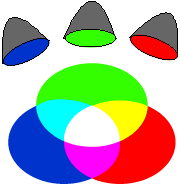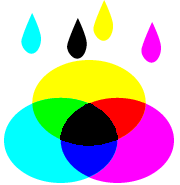GT users are rather familiar with these words: Recently you see and hear the terms like "Color Matching" or "Color Management". Originally those terms are used when you use digital cameras, scanners, PC monitors, and color printers. Sometimes they found that your printer did not print as WYSIWYG (what you see is what you get).
Color matching is a technology for matching colors among different devices.
Rather surprizing, RED is not the same red between your pc monitor and printer. Remember, can you tell how "red" the apple is? How "red" the tulip is? There are a lot of reds all over the world.
In the digital color world, there are some standards to express the colors: L*a*b* explains how white, black, red, green, yellow and blue a color is. Color swatches like Pantone® and other "ink" or "paint" colors sometimes act like the standard of a certain business world. People are struggling with the definition of specific colors and you will never be free of this issue if you are creating digital colors!
Why colors don't match among different devices? Well, look at the images below. The left image
shows RGB red, green and blue, and the right image shows
CMYK, cyan, magenta, yellow and black.
|

 
|
The left image shows "Additive Colors", which is the way to represent colors by emitting RGB color lights. Additive colors are for TV, PC monitor, video, scanner, camera. As adding lights produces, lightness and chrome (saturation) increases. Therefore Black is represented with no lights, the darkness.
|
The right image shows "Subtractive Colors". This is the way for printing, a color printer prints color ink to produce multi-colors, using "only" 4 process inks. If you need red, a printer doesn't use red ink but combines Magenta and Yellow ink together and makes red on the printed material. Contrary to addictive colors, lightness and chrome (saturation of color) decrease as inks are mixed. When you combine Cyan, Magenta, and Yellow ink all together, you can produce black in theory. But actually this combined color looks like dark reddish brown, that's why black (K) ink is added to CMY ink. Then how do you think a printer produces white? There is "no ink printed". If a print medium is white, then a printer can produces "white".
|
Now you see that in RGB lights or CMYK inks, every device produces multi-colors
following its own rules of mixing color elements.
Color Matching (or Color Management) is a technology to match colors among different color gamuts, different devices. So our printer driver has a lookup table to match colors, which is called color profile, between sRGB (Windows®
standard) and GT-3 CMYK. Generally speaking, RGB color gamut is wider than CMYK color gamut except the 100% Cyan, Magenta, Yellow points. You can make an artwork image on a PC monitor, in the light world, the wider color gamut but no brilliant fluorescent colors are in CMYK. Therefore the algorithm to compress (or map) RGB color gamut into CMYK color gamut is one of the most important technologies. This enables users to make artwork on the PC and print from a priter in the appropriate colors.
|
By color matching technology, color gamuts of each devices are matched by mathmatics. There are more than 16 million colors handled in the digital color world and most of those colors are complemented values by calculation. We said that color matching
is a kind of translation among different devices. So the most important is:
|
| |
 If you want to keep the original accuracy, the number of translation (color matching) is "the lesser, the better". Click here for more info of color profile. If you want to keep the original accuracy, the number of translation (color matching) is "the lesser, the better". Click here for more info of color profile.
| |
|
As the result, the best way to get best print is to take care of color settings of each application and set color mode of artwork file as RGB, use RGB color palette to fill objects because GT-3 is non-PostScript RGB printer. These settings will bring color values directly to the GT-3 with the highest accuracy of color matching translation.
|
|
|
Simultaneously, please take care of other devices' color settings such as PC monitors, scanners and digital cameras, because those devices also require a lot of care in color matching. These settings will work or kill the printer driver color matching. If your customer wants to know how to get a better print, show them the way to make better artwork.
|
The types of printing media may change color reproduction. Our standard is Hanes® Beefy-T® because it is thick enough and its stitches are tight so that ink colors reproduce clearly. Some thinner or cotton-mix materials are less color-reproductive.
|